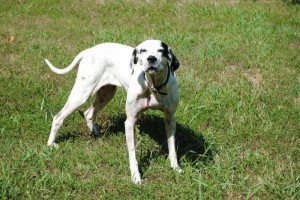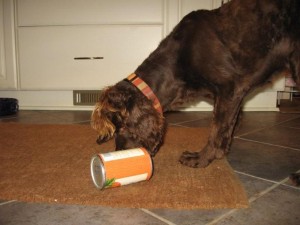By Margaret Bishop
My sister’s dog died in February and she has just started to look for another dog. Still in the throes of grief and longing, she has a very explicit idea of what her new dog will be like. She will be just like her former dog, only three years old. She and her husband have composed a one page document entitled, We want a dog who…
This reads like a Match.com profile written by Goldilocks. The dog must have large soulful eyes, a medium coat and be beautiful. She must have a strong desire to please, be easy to train and smart, but not an independent thinker. She must want to be with them, but not clingy. She must be friendly to people and other dogs but not actively seek attention. It goes on in this vein, very specific about their wants and even more detailed on their don’t-wants. This is a method that is recommended for people looking for a dog, and is considered invaluable in assuring a successful adoption.
As I was reading this and perusing some of her choices on Petfinder.com (world’s most dangerously addictive web-site) my new adoptee was sleeping nearby. The spaniel, sleeping next to her, shifted slightly and his paw may have barely grazed her tail. She let out her signature bark, a high pitched, hoarse yelp that startles as much as it grates. Then she stood up, gave him a baleful look, gave me a pleading look and climbed on the couch.
I didn’t make a list of likes and dislikes before I went to the shelter. Until I met her, I couldn’t know.
I brought Pied home on December 28th from a local ASPCA. I had gone to look at what was described as an elderly pointer. This was a nice dog, but not a good fit with my dogs and to be honest, not one who spoke to me. I feel guilty even admitting that I could be so fickle, but I was. I told the volunteer that I might just look around. She said, “There’s another pointer in the run next to hers. She’s only two, but do you want to see her?” When I agreed, she hesitated and then said, “She’s a little vocal.” She rushed to assure me, “But just when you first come to her pen.”
We went to look at her and that was the first time I heard the signature yelp, hoarse and piercing, only now it was a cry that went on and on. Out in the large run, she tried to play with my dogs, but if they so much as considered sniffing her, she howled and ran away. She was like a lonely creature from another planet, desperate for something but terrified of everything that was offered. She came to me and allowed me to pat her, but then had to return to racing around the run, play bowing at my dogs and then crying pitifully when they responded. I took her on a short walk, and she very nearly climbed the trees her exuberance was so great to be outside and moving, even if her freedom ended at the buckle of the six foot leash.

Pied
I had promised to be responsible, so I returned the dog to the volunteer, told her I had to think about it and that I would call the next day. “OK, but just so you know, we can’t hold her for you.” My friend, Tracey, who had come along to make sure I behaved responsibly, had to pinch me hard, but I agreed to accept that risk and turned to gather up my dogs.
As the volunteer headed across the parking lot and back toward the building, the dog commenced vocalizing again, guttural cries and yelps. She stared beseechingly at me, as her paws scrabbled on the pavement and her entire body yearned towards me.
Driving home, Tracey said, “I’m not going to say a word. I don’t want to influence you, so just tell me what you thought.”
“Oh, I’m definitely getting her. I love her. I’m definitely taking her.”
She smiled, shook her head and said, “You really like a project.”
Two days later, Pied was standing in my kitchen, whining, terrified to move on the slick floor.
I was worried that her bark was hoarse from overuse, that she might be an incessant barker. But she isn’t. The bark always means something. Sometimes it means she is excited because we might be going for a walk, or getting ready for a meal, or because the other dogs are excited; sometimes it expresses alarm and dismay as when another dog touches her; sometimes it means we are in the car and the other dogs are touching her and we are certainly going for a walk. She vocalizes a lot in the car. When Tracey and I were discussing what this dog’s job would be if she were a person, she said, “Whatever she does, she has Tourettes.”
If I leave her in the car to run into the store or the bank, she cries loudly and piteously. Once in the post office, I was getting my mail and I could hear her howling. Behind the PO boxes, one postal worker said to another, “What is that? It sounds like it’s in pain.”
If other dogs play, she wants to be part of it, but all she knows how to do is bark and run away. If a dog actually tries chasing her, she runs directly to me and starts yelping and crying at them, an expression of fear and accusation in her tone and on her face. The dog walks away, disgusted, and I stroke her ears and try to reassure her.
But Pied hasn’t been a project. She has beautiful house manners, and after only a few days of training she developed an extremely reliable recall. Because she is so consistent about staying with me and coming when I call, she can walk off leash. Well, I walk, she runs her legs off. In the middle of a full tilt gallop, she’ll abruptly freeze into the most classic point and start the slow pointer creep, each paw lifted, held and oh so silently placed down again. Very often she is creeping up on a leaf or a shadow, but never mind, she’s off again. When she isn’t pointing, she runs just for the joy in motion, nose inches from the ground, legs never seeming to coordinate with each other in any sort of consistent rhythm. And then she’ll abruptly hurl her body to the earth and roll, all four legs thrashing wildly in the air, paddling away as she wriggles through the wet grass. She gets up drives her chest into the same spot and slides her chin along the ground. Then she is up and running.
Now that it’s hot, she does this in streams. Galloping along, mouth open, water splashing into her mouth, across her face, up onto her belly, she is a wonder to behold. She won’t swim but she’s got a killer wade. Tracey said, “That dog just freebases life.”
She sleeps right next to my head and when we wake up in the morning, she groans a little, creeps closer and lays her chin gently across my face.
If I had written down what I wanted in a dog, I wouldn’t have said — I want a dog with the temperament of a car alarm, the social skills of a frightened wolverine and the car manners of a chimp on amphetamines. But it turns out, that’s exactly what I wanted.
Margaret Bishop is a writer living in Northern Virginia with her four unemployed dogs.

